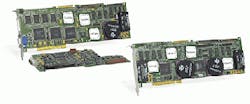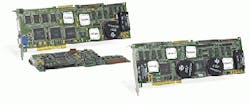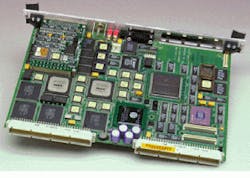DSP-based processing boards boost output
DSP-based processing boards boost output
By Rick Nelson, Contributing Editor
Spurred by digital-signal processor (DSP) developments, imaging- processing-board vendors are now offering higher levels of performance for system integrators of machine-vision systems. DSPs do more than bring sheer processing muscle to image-processing applications. By accommodating one or more processors, they allow developers to tailor processor count to their application needs and furnish optimum price-performance levels.
In many DSP-based imaging applications, the host PC is relegated to housekeeping chores, while one or more DSPs perform vision-related tasks.
Although host-based MMX technology targets the high-speed pixel manipulation required for fixed-point imaging applications, the capability of DSPs is more useful in applications that require floating-point or multiprocessor capability.
Merging techniques
While Intel has pursued MMX for multimedia applications, Texas Instruments (TI; Dallas, TX) has honed its floating-point DSP technology. The result is TI`s TMS320C6xx DSP family, whose newest member, the C67x, delivers 1 GFLOP. Concurrently, Loughborough Sound Images (Loughborough, Leicestershire, England) is collaborating with TI to develop imaging systems and communications platforms based on the `C67.
Other vendors are also focusing on TI`s processors. Coreco (St-Laurent, Quebec, Canada) has introduced its C6200-based Python/C6 board that provides 6400 MIPs from up to four 200-MHz TMS320C6201 DSPs. On-board interfaces to PCI Mezzanine Card (PMC) and Industry Pack (IP) modules provide a multifunction building-block approach to system integration. The board incorporates the firm`s 160/200-Mbit/s COALA (COreco Auxiliary Link/Access) open-architecture bus to provide interconnection with image-acquisition boards.
TI`s TMS320C80 has also found use in image-processing tasks. As a multiprocessor DSP, the device combines four signal-processing units plus a RISC-based master processor to provide 2 billion fixed-point operations per second. Used by Precision Digital Images (Redmond, WA) on its Precision MX Video Engine, the C80 is used in a PCI bus-mastering configuration and can support resolutions up to 1024 ¥ 768-8-bits.
Matrox`s Genesis also uses the C80 processor (see Fig. 1). Genesis is an imaging subsystem that provides image acquisition, processing, and nondestructive display within the PC environment for machine-vision, image-analysis, and medical-imaging applications. Neighborhood operations accelerators, implemented in ASICs and tailored to pixel-manipulation tasks, complement the C80`s processing power.
The TMS320C80 is also popular on the VMEbus. DY4 Systems (Kanata, Ontario, Canada) recently unveiled its SVME/DMV-783 VME board targeted at cockpit avionics displays, moving map systems, and other military graphic and image-processing applications. The single-slot VMEbus board uses a C80 processor and can simultaneously update dual displays, perform high- resolution RGB/NTSC frame grabbing, and gather high-speed digital data from radar sets and remote sensors.
Shac attack
Other processors such as Analog Devices` 120-MFLOP Sharc are providing scalable processing power for specific imaging applications. Analog Devices` processor is currently at the heart of Alacron`s FT-Dominator, a board that supports 1 to 96 40-MIPS ADSP2106 x Sharc floating-point processors.
The first member of the FT-Dominator series is a scalable array of as many as eight Sharc processors that are interconnected using Alacron`s Dual Ported Local Memory (DPLM) architecture. This eliminates processor contention for off-chip memory and allows the memory bandwidth of the Sharc array to scale linearly with the number of processors used. A two-dimensional direct-memory access (DMA) engine isolates the Sharc array from the system bus, reducing the impact of system bus traffic. In addition, the FT-Dominator includes VME64 and PMC interfaces. Through the latter, Sharc processors can provide DMA over Myrinet, Myricom`s full-duplex network that supports communication rates beyond 1 Gbit/s. An on-board Pentium P5 processor performs operating-system functions, off-loading the Sharc array for image-processing tasks.
Boards vs. subsystems
Image-processing boards range from dedicated CPUs to complete one-board imaging subsystems. For example, DY4`s SVME/DMV-783, a one-board subsystem, includes two separate frame buffers and two video DACs for dual-display operation. Analog and digital video-overlay features allow graphics and text to be mixed with live video displays. An optional 41 pins of buffered digital input/output (I/O) support implementation of custom 64-Mbit/s, 32-bit interfaces, with nine signals available for control. Optional video frame-grabber mod ules accept RS-170, RS-330, and RS-343A video inputs.
Similarly, Matrox`s Genesis provides full image-acquisition to display-controller performance, with programmable mezzanine grab modules that can acquire data from many monochrome/color, analog/digital, and framescan/linescan video devices. Genesis includes the Matrox MGA 2064W graphics accelerator and WRAM for display control.
Rather than using a standard DSP, Datacube`s mvPower single-board image processor combines a 100-MHz Motorola PowerPC 603e with four custom image-processing ASICs. These ICs comprise an ALU and three virtual-surface image-memory modules that implement Datacube`s proprietary pipeline-processing technology. The mvPower board is supplied in a single-slot VMEbus configuration and is expected to be joined by a PCI version soon. The mvPower-PCI board should accommodate PowerPCs at speeds to 500 MHz as they become available (see Fig. 2).
In contrast, Sky Computers` SKYbolt boards that can accommodate Sharc or Intel i860 processors, require external components for data acquisition and display control. Advanced NMR Systems (Wilmington, MA) uses SKYbolt boards in its InstaScan magnetic-resonance-imaging (MRI) systems that use echo-planar imaging (EPI) techniques to reduce image-acquisition times to 1/20 s. This speed improvement increases patient throughput, reduces costs, and increases accuracy by reducing distortion due to unavoidable patient movement during long scan times. Furthermore, the rapid EPI image-acquisition times enable the tracking of dynamic physiological processes such as blood flow and heart beat. The VME-based InstaScan employs standard COTS components except for a custom host buffer board.
Mercury Computer Systems (Chelmsford, MA) is also providing computational power for demanding image-processing tasks, such as SAR (synthetic aperture radar) and STAP (space-time adaptive processing) radar applications. Last summer, Mercury delivered a 20-processor, 576-Mbyte RACEway-based computer system to Sandia National Laboratories (Albuquerque, NM) for use in SAR systems. The company also recently received an order for a 100-GFLOPS RACE system from MIT Lincoln Laboratory (Lexington, MA), under contract by Northrop Grumman, to develop improved STAP systems. RACE systems use i860, PowerPC, or Sharc daughtercards and can provide up to 4 GFLOPs.
Computational demands of MRI and radar applications far outstrip the capabilities of general-purpose CISC processors. In such applications, image-processing boards are more likely to use CISC-based processors as host CPUs while dedicated hardware handles real-time image-processing tasks. And, despite the inroads made by general-purpose processors and multimedia extensions, dedicated image-processing hardware will, in the future, continue to surpass host-processor capabilities.
FIGURE 1. A single-slot board for the PCI bus, the Matrox Genesis accepts mezzanine cards for data-acquisition options and processing performance, which scales to more than 100 billion operations per second for a six-processor-board configuration.
Intel i860 TI C40 ADI 21062 PowerPC 740
Processor Specs
CPU clock (MHz) 40 50 40 250
Memory bus 160 Mbit/s 2 * 200 Mbit/s 160 Mbit/s 83 MHz
On-chip memory 4 Kbit Instr cache 8 Kbit Data cache 0.5 Kbit Instr cache 8 Kbit RAM
256 Kbit RAM 32 Kbit Instr cache 32 Kbit Data cache
Processor benchmarks
1K CFFT (ms) 0.75 1.28 0.46 0.3
1K CFIR (64 taps) (ms) 1.78 1.48 1.79 0.5
Typical 6U VME implementations
Processors per board 4 8 12 4
MFLOPS per board
(single precision) 320 400 1440 (for FFTs) 2000
(240 double precision) 960 (non-FFT)
$/MFLOP on a board 78 54 18 (FFT) 13 27 (non-FFT)
Software trade-offs
Software tools Mature, high-level, Mature, low-level Immature but Mature, high-level, intelligent growing rapidly intelligent
Effective algorithms Complex DSP Small embedded DSP On-chip FFTs for Complex DSP and algorithms with off-chip applications front-end sonar, radar, data-processing accesses (for example, and signal processing algorithms with
computer telephony) large data sets
TI chips have found a home in computer telephony because of their low cost and all-around DSP performance. The SHARC excels at fast Fourier transforms that fit into the on-chip SRAM, but performance drops off if off-chip accesses are required. This, combined with the high density at which you can populate a board, makes the SHARC an excellent choice for front-end signal processing of limited-sized data sets. For larger data set sizes and good performance beyond the tight inner loop, the PowerPC 740 is the best choice.
FIGURE 2. A 100-MHz RISC processor works with four custom ASICs to deliver pipelined processing power on Datacube`s mvPower boards. This single-slot VMEbus version is scheduled to be joined by a PCI version before year-end.
Image-processing-board manufacturers--a sampling
Alacron l Nashua, NH 03060 l (603) 891-2750 l Fax: (603) 891-2745 l E-mail: [email protected]
Active Imaging l Berkshire SL6 4UB, England l (0) 1628 415444 l Fax: (0) 1628 415400l
BitFlow Inc. l Woburn, MA 01801 l (781) 932-2900 l Fax: (781) 933-9965 l E-mail: [email protected]
Cognex l Natick, MA 01760 l (508) 650-3000 l E-mail: [email protected] l
Coreco l (514) 333-1301 l St-Laurent, Quebec H4T 1V8 Canada l Fax: (514) 333-1388 l E-mail: [email protected]
Datacube l Danvers, MA 01923 l (978) 777-4200 l Fax: (978) 777-3117 l E-mail: [email protected]
Data Translation l Marlboro, MA 01752 l (800) 525-8528 l Fax: (508) 481-8620 l E-mail: [email protected]
Dipix Technologies Inc. l Ottawa, ON, K2C 3P1 l Canada l (613) 596-4942 l Fax: (613) 596-4914 l E-mail: [email protected]
DY 4 Systems l Kanata, Ontario, Canada l (613) 599-9191 l Fax: (613) 599-7777 l E-mail: [email protected]
Epix Inc. l Buffalo Grove, Il 60089 l (847) 465-1818 l Fax( 847) 465-1919 l E-mail: [email protected]
Imagenation l Beaverton, OR 97006 l (503) 641-7408 l Fax: (503) 643-2458
Imaging Technology l Bedford, MA 01730 l (781) 275-2700 l Fax: (781) 275-9590 l E-mail: [email protected]
Imagraph Corp. l Chelmsford, MA 01824 l (978) 256-4624 l Fax: (978) 250-9155
InSync Technologies l San Leandro, CA 94577-5515 l (510) 895-6800 l Fax: (510) 895-6899 l E-mail: [email protected]
Loughborough Sound Images l Loughborough, Leicestershire, England l (0) 1509 634444 l Fax: (0) 1509 634450
Matrox l Dorval, Quebec, Canada H9P 2T4 l (514) 685-2630 l Fax: (514) 685-2853
Mercury Computer Systems l Chelmsford, MA 01824 l (978) 256-1300 l Fax: (978) 256-3599
MuTech Corp. l Billerica, MA 01862 l (978) 663-2400 l Fax: (978) 663-3444 l E-mail: [email protected]
Peritek l Oakland, CA 94619 l (510) 531-6500 l Fax: (510) 530-8563
Precision Digital Images l Redmond WA 98052 l (800) 678-6505 l Fax: (425) 867-9177 l E-mail: [email protected]
Sensoray l Tigard, OR 97223 l (503) 684-8005 l Fax: (503) 684-8164
Sky Computers l Chelmsford, MA 01824 l (978) 250-1920 l Fax: (978) 250-0036
Teknor Industrial Computers l Boisbriand, Quebec, J7G 2A7 Canada l (514) 437-5682 l Fax: (514) 437-8053 l E-mail: [email protected]


